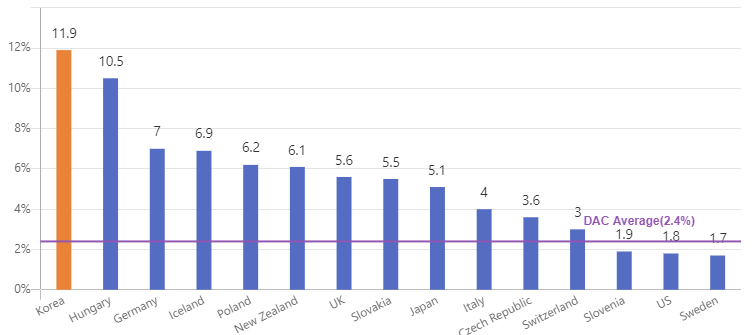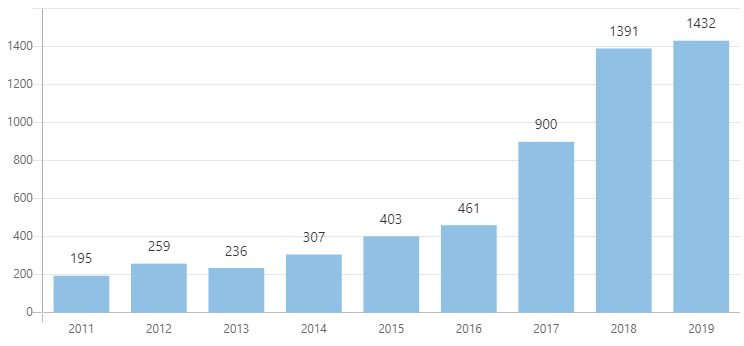Korea’s Enhanced Global Standing as a
Middle-power Donor Country
Since its accession to the OECD DAC, Korea has
been making proactive efforts to integrate development into the agenda
of key global fora and to play a bridging role between developed and
developing countries.
Setting a milestone for international
development cooperation
At the 2010 G20 Seoul Summit, Korea exercised
an active role in the presidency of the G20 based on its successful
development experience and added development to the G20 agenda for the
first time, leading to the adoption of the Seoul Development Consensus
for Shared Growth as well as the Multi-Year Action Plan on
Development. Through this occasion, Korea laid a solid foundation for
continued discussion of the development agenda at the G20—the most
high-profile meeting for international economic cooperation. This is a
prime example in which Korea served a bridging role between developed
and developing countries.
Moreover, in 2011, the Korean government
hosted the Fourth High Level Forum on Aid Effectiveness (HLF-4) in
Busan. As the host country, Korea took leadership in bringing about a
paradigm shift from ‘aid effectiveness’ to ‘development effectiveness’
and the signing of the Busan Partnership for Effective Development
Cooperation, which set forth a new framework for a global development
partnership embracing a diverse set of development actors.
Particularly, the Korean government brought together powerful emerging
donors—e.g. China, India, and Brazil—and performed a leading role in
launching the Global Partnership for Effective Development Cooperation
(GPEDC). Since 2014, Korea has been organizing the Global Partnership
Forum on an annual basis, with the objective of contributing to the
achievement of development effectiveness and to the
institutionalization of the GPEDC.
In 2015, Korea took up the chairmanship of the
Multilateral Organization Performance Assessment Network (MOPAN),
which is the only network of donor countries that assesses the
effectiveness of multilateral organizations. Given that donor
countries are using the assessment findings as an important source of
input for decision-making on multilateral assistance, the Korean
government’s assumption of MOPAN’s chairmanship was an opportunity to
expand Korea’s influence on multilateral development organizations
while playing a responsible and fair role in global development
cooperation, and to raise Korea’s standing on the global stage.
Globally recognized for its proactive
contribution as a donor country, Korea was elected to the presidency
of the Executive Board of the UN Development Program (UNDP), the UN
Population Fund (UNFPA), and the UN Office for Project Services
(UNOPS) in 2019. As the president of the Board, Korea built a
cooperative relationship with civil society and the private sector,
and broadened participation in a wide variety of development issues,
with a view to bringing about the systematic changes of these three
organizations that perform a pivotal role in development cooperation.
In the same year, Korea was also elected as vice chair of the OECD
DAC. These occasions demonstrate the international community's
appreciation of Korea as a model of development and expectation for
Korea's decisive role in future development cooperation.
While already assuming a leading role in
climate change response through the launch of the Global Green Growth
Institute (GGGI) and the establishment of the permanent secretariat of
the Green Climate Fund (GCF), Korea was elected in 2019 as vice chair
of the Subsidiary Body for Implementation (SBI) of the United Nations
Framework Convention on Climate Change (UNFCCC). At the SBI, which
oversees the overall implementation of the Convention, the Korean
government is performing a vital role in supporting the international
implementation of the UNFCCC objectives.
Contributing to Global Development
Efforts
Increasing the volume of ODA
Even before its accession to the OECD DAC,
Korea was continuously scaling up its ODA volume and number of ODA
projects. Most notably, the year 2018 saw the ODA budget exceeding KRW
3 trillion for the first time, a 2.4-fold increase from the year 2010
when Korea joined the DAC.
Since becoming a member of the DAC, Korea has
raised its volume of ODA disbursements at a phenomenal rate. From 2010
to 2019, Korea’s ODA grew from USD 1.17 billion to USD 2.42 billion,
increasing by approximately 106%. During the same period, Korea’s
average annual growth rate of ODA disbursements stood at 13.5%, the
highest among DAC members (the DAC average was 2.6%). These figures
indicate the Korean government’s commitment to make substantive
contributions to global development cooperation efforts by increasing
its ODA volume.

Embracing efforts to achieve SDGs
The Korean government has contributed to the
adoption of the 2030 Sustainable Development Goals (SDGs) through its
active participation in the intergovernmental negotiation process, and
declared its commitment to meeting the SDGs at the UN Sustainable
Development Summit in September 2015. Also, in the Framework Act on
International Development Cooperation and the Second Mid-Term Strategy
for Development Cooperation (2016-2020), the government set the
contribution toward global implementation of the SDGs as one of its
priority policy objectives. Throughout this process, the Korean
government solidified its commitment to supporting the implementation
of SDGs by developing countries.
While continuing active engagement in the
discussions of the annual UN High-Level Political Forum on Sustainable
Development (HLPF)—the central platform for follow-up and review of
the SDGs’ implementation—Korea participated in the Voluntary National
Reviews (VNRs) in 2016 and shared its progress toward the SDGs with
the international society. Particularly, in line with the government’s
vision of "Inclusive Korea," the Permanent Mission of the Republic of
Korea to the UN took the initiative and chaired the Group of Friends
of SDG 10 (“Reduce inequality within and among countries”). With a
view to reducing inequality and increasing inclusiveness, Korea is
taking part in the relevant international discussions.
Domestically, the Korean government introduced
the framework for monitoring the nationwide progress made for the
implementation of SDGs (“K-SDGs”) in 2018, which reflects the unique
conditions and circumstances of Korea.
Enhancing humanitarian assistance
The Korean government has been stepping up
efforts to contribute to resolving humanitarian crises around the
world, actively participating in the global humanitarian response to
large-scale conflicts (e.g. in Syria, Yemen, and Iraq), refugee
crises, and peace-building and reconstruction challenges.
At the national level, the government has been
establishing and consolidating the domestic legal and institutional
framework for humanitarian assistance; in accordance with the Overseas
Emergency Relief Act (enacted in March 2007), the government
instituted Basic Overseas Emergency Relief Measures (revised in
January 2020), and introduced the Humanitarian Assistance Strategy
(revised in July 2019) for effective delivery of humanitarian
assistance. In February 2020, Korea joined the Grand Bargain—an
agreement between donors and humanitarian aid agencies on shared goals
and commitments to strengthen the efficiency and effectiveness of
humanitarian aid—to take part in international efforts to enhance
humanitarian assistance.
In addition to consolidating the domestic
institutional framework for humanitarian assistance, the Korean
government has continued to scale up its humanitarian aid budget since
2011. The latest figures indicate that the 2019 budget amounted to KRW
143.2 billion, a sevenfold increase since 2011. Moreover, the share of
humanitarian aid budget in the total ODA budget has been on the rise
since 2013.

The Korean government is also dispatching
emergency relief teams to large-scale overseas emergencies,
proactively undertaking relief efforts in hard-hit regions. Past
examples include the 2013 Super Typhoon Haiyan in the Philippines, the
2014 Ebola outbreak in West Africa, the 2015 Nepal earthquake, and the
2018 Laos dam collapse.
Establishing the Korean ODA model and
sharing Korea's development knowledge
Capitalizing on its own development experience
and on its internationally recognized strengths in ICT and public
administration, the Korean government has endeavored to provide
development assistance that is differentiated from traditional ODA.
The 2012 OECD DAC peer review assessed that Korea’s comparative
advantage as a donor is possessing the Korean model of ODA drawn from
its actual development experience. Indeed, Korea has been supporting
various development projects in a broad range of areas, offering
policy consultations on development experience and consulting
programs—e.g. the Knowledge Sharing Program (KSP) and the Development
Experience Exchange Program (DEEP)—based on its successful experience
in development, while the government is undertaking efforts to link
these activities to actual ODA projects. Korea is also leveraging its
comparative advantages in ICT and public administration, and expanding
the scope of development assistance by linking them with other sectors
such as education and health.
